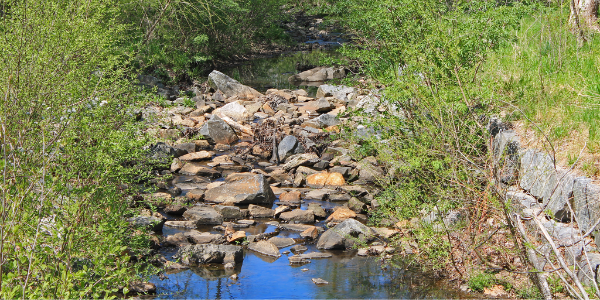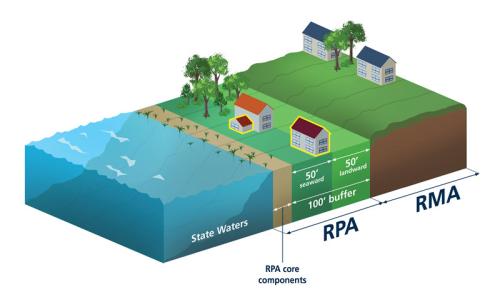
The Chesapeake Bay is one of the world’s most productive coastal water bodies, and it collects water from county streams and rivers. Learn more about the bay and get involved in keeping it clean as we recognize Chesapeake Bay Awareness Week, June 7-15.
Keeping the Bay Clean
If you want to help to keep the bay clean, visit the Fairfax County Restoration Project, a public/private partnership made up of private businesses, non-profit organizations, government agencies at the state, regional and county level, and individuals concerned with our quality of life.
More events and activities are also available on the Chesapeake Bay Program website.
Resource Protection Areas
In an effort to protect and improve the quality of the waterways that drain into the Chesapeake Bay, Fairfax County designated environmentally sensitive areas known as Resource Protection Areas (RPAs) through the Chesapeake Bay Preservation Ordinance (CBPO) in 1993.

Resource Protection Areas are regulated corridors of environmentally sensitive land that lie alongside or near the shorelines of streams, rivers and other waterways. In their natural condition, RPAs protect water quality, filter pollutants out of stormwater runoff, reduce the volume of stormwater runoff, prevent erosion and perform other important biological and ecological functions.
The Chesapeake Bay Preservation Ordinance was recently amended to include provisions related to coastal resilience and adaptation to sea level rise. The changes require consideration of the impacts of climate change, such as sea level rise and storm surge, for land development that occurs within RPAs (Note: the water level of the Potomac River has risen 13.56 inches since 1920, or 0.135 inches per year, and is projected to rise an additional 1 to 3.5 feet by 2050). This amendment is in alignment with both legislation at the state level and the county’s Resilient Fairfax plan, which guides efforts to adapt to changing climate.
Why Should These Areas Be Protected?
Protecting and preserving the environment for the next generation is very important to the community and a key focus of the Countywide Strategic Plan. The goal is to protect, conserve and sustain environmental resources to promote clean air, water and soil. To confront the challenges posed by climate change, the county will improve the resilience of natural resources and community infrastructure, including our waterways.
Where Are RPAs in Fairfax County?
This interactive RPA map allows residents to enter a property address to view the watershed and RPA boundaries. JADE is a more comprehensive mapping application with over 170 layers to view, combine and analyze. The RPA boundary is one of the available layers in the online GIS system. Further instructions are available.
In addition, for new owners or as a reminder for existing owners, our Land Development Services department sends a postcard annually to the owner and property address (if different) of any parcel that has an RPA on it.
What Property Owners Should Know About RPAs?
Any development, land disturbing activity or other use within an RPA generally requires prior approval from the county. This can include decks, patios and removal of non-native invasive species and dead or dying trees. For information regarding a specific project and associated application requirements, visit our Chesapeake Bay Preservation Ordinance webpage or contact a stormwater specialist at 703-324-1720, TTY 711.
Ways To Protect the Bay and the Environment
Don’t be a litter bug! One of the biggest ways everyone can help protect our waterways is to properly dispose of trash including plastic items that are not bio-degradable. Plastic pollution and bags in particular clog up local waterways that feed into the Chesapeake Bay.
When it rains, excess fertilizer runoff also harms the health of our creeks, streams and the Chesapeake Bay.
If you think you need to fertilize your lawn, think of how excess fertilizer can harm the Chesapeake Bay first. Most grasses in Northern Virginia are cool-season grasses that don’t require year-round fertilizer, and feeding your lawn at the wrong time of year can actually hurt your grass in the long run.
A soil test is the best tool available for determining if fertilizer is actually needed. Learn how to get your soil tested at Virginia Tech’s Soil Testing Laboratory from the Northern Virginia Soil and Water Conservation District.



 SIGN UP FOR DAILY EMAIL HEADLINES
SIGN UP FOR DAILY EMAIL HEADLINES